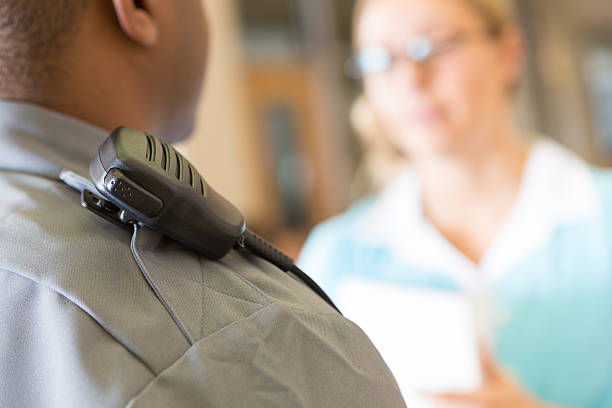
In the wake of the tragic elementary school shooting in Uvalde, Texas, law enforcement, school officials, and security professionals across the country are asking questions about preparedness in local schools.
As scrutiny of the handling of the school shooting at Robb Elementary School ramps up, physical security experts are trying to understand what may have gone wrong and how school districts can act more effectively in the future. Training, integration, and enforcement (T.I.E.) are three key areas that contribute to the overall effectiveness of a school’s security posture. In this article, we will share how school districts can address each area without compromising their commitment to educational excellence and safety.
Training, Integration, and Enforcement
The Cybersecurity & Infrastructure Security Agency (CISA) has an extensive guidebook designed and organized for local education agencies to employ in conjunction with the K-12 School Security Assessment Tool (SSAT), a web-based tool that provides further guidance on school physical security planning and implementation.
This guide demonstrates how taking a systems-based approach to layered security can help schools create safe and secure learning environments without “requiring principals, assistant principals, facility managers, and other staff to become security experts”.
Three major takeaways for local education agencies to keep in mind as they plan to improve physical security at their school campuses are:
- Training is an instrumental component that enables schools to be better able to detect, delay, and respond to threats.
- Integration is required for physical security systems to work effectively.
- Enforcement enables schools to prevent threats, and activities to respond to and recover from the consequences of a diverse set of safety incidents.
While there is no one-size-fits-all approach to a school’s physical security, the T.I.E framework provides schools with a manageable security framework. The prevalence of gun violence in the United States once again renews the focus on being prepared for these tragic situations. Let’s review the Uvalde incident and see how we can learn from this tragedy.
Uvalde will Impact School Security for Years to Come
Make no mistake about it, the Uvalde tragedy will be studied by security experts, school officials, and policymakers for years to come. Like Columbine, the Uvalde tragedy is forcing many school security experts to go back to the drawing board and rethink school security.
Post-Columbine (April 20, 1999), a New York Times analysis documented that 35 shootings killed a combined 446 people. At the time, the police response to Columbine was heavily criticized, which led to a drastic change in active shooter incident response nationwide. In the aftermath, immediate action rapid deployment (IARD) tactics replaced scene containment, leading to the department’s training and equipping personnel for a solo officer response.
Without question, Columbine changed the way schools should protect themselves with security measures. It also changed how police approach and access a school in the event of an emergency but as we saw in Uvalde, it was not enough.
Rethinking School Security Training
While much of the attention remains on the officers’ botched response, security experts know that an active shooter response is the culmination of many elements regarding school security.
An effective response to an active shooter event requires adequate planning and role reinforcement through training for personnel caught in the event and for district leaders coordinating the response to the event.
School police officers are trained in best practices for stopping an active shooter. Still, most people only focus on law enforcement response, and Uvalde reminded us that a one-dimensional approach is not enough.
Training – School Security Requires a Multidisciplinary Approach
A multidisciplinary approach requires conceptualizing school physical security as a component of the broader school safety system. Such an approach also includes the elements of prevention and response and recovery.
Districts rely on school resource officers (SROs), police officers, and other assigned security personnel to respond to an active shooter incident. Still, they only represent the tip of the spear when it comes to school security. A multidisciplinary approach to school security training includes:
- Security awareness training
- Mediation and conflict resolution
- Disaster and emergency planning
- Physical security systems training
Within a multidisciplinary approach, training programs work cohesively to provide security benefits. As outlined in the CISA K-12 school security guide, the school safety system consists of three fundamental components: Prevention, Protection & Mitigation, and Response & Recovery.
All three components require training and awareness, especially when it comes to active shooter (active assailant emergencies) and lockdown procedures.
Active Shooter Training
Incidents involving active shooters frequently change swiftly and without warning. As a result, anyone may contribute significantly to reducing the effects of an active shooter scenario amid pandemonium. Because of this, schools must approach active shooter drills as a community rather than an isolated incident.
The active-shooter situation training for each school must engage the participation of the following key members:
- District school safety specialist,
- Threat assessment team members
- Faculty, staff, and students
Finally, the training should be conducted or at the very least coordinated by the law enforcement agency or agencies designated as first responders to the school’s campus. Detection of the threat on school grounds can activate subsequent security measures at other layers, such as automatic door locks and lockdown procedures to protect the building perimeter and interior sections.
Lockdown Training
With few exceptions, lockdown drills are required by law and conducted at least two times each school year. Schools must conduct lockdown drills at least once during each session’s first 20 school days. In addition, many school districts have voluntarily taken it upon themselves to run additional drills, such as lockdown, shelter-in-place, and others, to prepare for various threats.
Regarding lockdown training and awareness, schools should consider several best practices for more effective responses and greater safety when a critical incident does occur, such as:
- Collaborative planning
- Repeated practice
- Modification of drills based on feedback and evaluations
Regular training allows school staff and personnel to practice their roles in simulated emergencies and increases preparedness for worst-case scenarios. While training, policies, and procedures are essential, effective security systems integration is crucial to establishing a resilient and sustainable security environment.
Integration – School Physical Security
Experts testified that the Uvalde massacre began after the gunman entered the school through a door that could only be locked from the outside and then got inside a classroom that had a busted lock. Securing doors has long been a focus of school safety drills, and the inability to do so highlights the importance of physical security and having standardized procedures in place.
School physical security systems include physical security tools and technologies, structural elements, human resources, policies and procedures, and associated training requirements.
While the effectiveness of school hardening is debatable, locking all exterior school doors and requiring visitors to enter through a single entrance is a security measure that is widely accepted. As a result, numerous districts have chosen to implement this simple fix.
Integrated systems help expedite responses and improve the ability of police to apprehend these individuals quickly. As these perpetrators who commit these crimes become more sophisticated, it is imperative to respond with an equally advanced security system.
Schools can improve their overall visitor management and active shooter response procedures with:
- Touchless screening systems use advanced sensor technology and AI to screen for weapons. In addition, these systems are less intrusive and more effective than traditional metal detectors when combined with other security technologies such as access control systems.
- Access control systems, especially those that use magnetic locks to block off areas of the building immediately. This gives individuals time to escape while restricting the shooter’s movements.
- Enhanced barricades- that prevent shooters from being able to fire their way through and delay their movements through the building.
- Surveillance systems enable authorities to track the movements of an active shooter to determine the best response. With real-time surveillance, they can do this and help direct those inside to safety. Being able to locate the shooter and understand where they are going will help first responders create a plan to apprehend them while minimizing the risk to life.
Well-integrated physical security systems can initiate critical communications, enact damage control, and get outside assistance on school grounds in a timely manner. In regards to active shooter preparedness, rapid response technology is critical.
Rapid Response Technology
Rapid response technology provides school leaders and responders with a wealth of advantages regarding increasing operational efficiencies, proactively identifying risks, and ensuring informed, rapid responses to security incidents.
An integrated security system will make a massive difference once law enforcement and emergency medical services (EMS) arrive. Rapid response technology features:
- District lockdown systems enable school officials to immediately lockdown for any emergency situation, including active shooter, natural disasters, and unsolicited visitors.
- Critical communications systems, such as IP call stations, mass notifications systems, IP intercoms and other VOIP systems that individuals can use in the event of an active shooter, contact with first responders must be made immediately.
- Shooter detection technology that automatically detects gunshots using acoustic and infrared verification facilitates faster response, potentially saving lives. . The system uses finely tuned sensors that listen for the acoustic properties of a gunshot and, in less than two seconds, provide police with alerts showing where, within 1 meter, the shots were fired.
By integrating all technology within a single security system, school districts are able to not only monitor events as they unfold, but also send law enforcement emergency notifications. This allows for efficient communication and clear instructions for how and where they can help.
Enforcement-School Security Enforcement Ties it all Together
So far, we’ve covered the importance of training and integration, but school security is ineffective without competent enforcement.
Enforcement, the act of compelling compliance with school safety rules and regulations, is essential to establishing and maintaining a strong school security posture.
Enforcement is the final element that “T.I.E.s” everything together. Schools must enforce their policies and procedures and establish clear expectations to keep students safe. Security policy enforcement consists of two components: detecting violations and taking action when a breach occurs.
Video surveillance is a powerful tool to reinforce positive student and teacher conduct and promote security awareness.
Video Surveillance to Enforce School Safety Policies
School districts can use video surveillance to ensure students, teachers, support staff, and visitors are adhering to school safety & security guidelines.
In addition to providing assistance during a security incident, video surveillance provides evidence of incidents involving harm or theft in classrooms, hallways, and other high-traffic areas.
Resources for Schools Post-Uvalde
In the wake of the shooting in Uvalde, Texas, there’s a renewed focus on school security. Resources have been made available throughout the country to improve school security and safety and for parents and families responding to the tragedy.
Schools in Texas will approach the 2022–2023 school year more proactively in light of the tragedy. Senate Bill 500, appropriated $100,000,000 to Texas Education Agency (TEA) for enhanced security measures to be implemented in public schools. Some of these measures include metal detectors at school entrances and bullet-proof glass or film for school entrances.
Texas school districts are required to comply with the following new safety standards:
- Conduct a Summer Targeted Partial Safety Audit
- Conduct an Exterior Door Safety Audit
- Ensure all campus staff (including substitutes) are trained on their specific LEA and campus safety procedures
- Schedule all mandatory drills for the school year
- Ensure all threat assessment team members are trained
- Review and, if necessary, update access control procedures
— For the new school year, access control procedures must include exterior door sweeps (ensuring doors are closed and locked) at every instructional facility at least once each week while instruction is being conducted.
- Convene the LEA’s Safety and Security Committee to review:
— the multi-hazard emergency operations plan (EOP)
— and, as a component of the EOP, the LEA’s active threat plan
The Texas Education Agency (TEA) extended the end date for the 2019-2021 School Safety and Security Grant Notice of Grant Award (NOGA). The new end grant end date is June 15, 2023. Grantees do not have to amend their applications to receive their revised NOGA.
States Provide Additional School Security Resources
Similar programs and initiatives were initiated throughout the country. For example, the New Hampshire Department of Safety’s Division of Homeland Security and Emergency Management made over $13 million available to New Hampshire schools under the effort, named the Security Action for Education program, or SAFE. Schools for the funding, which can be used for cameras and surveillance, technology to control access to school buildings, or emergency alerts.
Additional school security resources include:
- SchoolSafety.gov: This organization has plenty of helpful information and resources. Their grant finder tool is an excellent resource for schools that want to find applicable school safety and security funding opportunities.
- FEMA Grants: Grant funds are available for pre and post-emergency or disaster-related projects. These funds support critical recovery initiatives, innovative research, and many other programs.
Homeland Security Grant Program: This grant provides recipients with the resources required for the implementation of the National Preparedness System and working toward the National Preparedness Goal of a secure and resilient nation
Resources for Families
Most importantly, the National Child Traumatic Stress Network has developed resources to help children, families, educators, and communities navigate what they are seeing and hearing, acknowledge their feelings, and find ways to cope together. Additional resources include:
Conclusion
Everyone from parents to teachers and school officials agrees that classroom and campus safety are major priorities, but school security is often a complicated and sensitive issue requiring a comprehensive approach.
While nothing can substitute human-to-human interaction, combining physical security systems with traditional security measures can radically improve functionality and help schools improve their security posture, response, and recovery.
At 3Sixty Integrated, we are here to advance enterprise organizations across multiple verticals to develop and implement sustainable security solutions. With over 20 years of experience, our team designs, installs, and maintains custom security solutions to keep your organization and assets safe and secure. Ready to get started? Contact us today to schedule a 30-meeting consultation or call us at (877) 374-9894.

